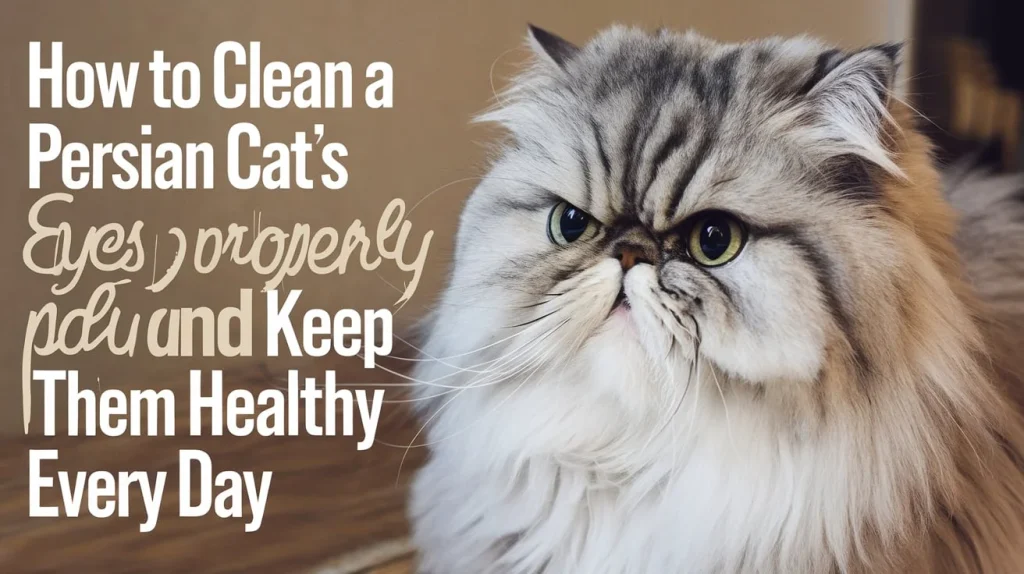Persian cats, with their iconic flat faces, soulful eyes, and plush coats, are stunning but require diligent eye care. Their brachycephalic skull structure causes tear overflow, leading to stains, discharge, and potential infections. Long fur around the eyes traps moisture and bacteria, while genetic issues like entropion (inward-rolling eyelids) can worsen problems. Daily cleaning is essential to prevent discomfort, maintain their beauty, and ensure long-term health. Here’s how to keep your Persian’s eyes sparkling clean and healthy.

Why Eye Care Matters
The Persian’s short nose and prominent eyes cause tears to spill over rather than drain properly, creating wet, stained fur that’s a breeding ground for bacteria. Left unchecked, this can lead to painful infections, skin irritation, or even vision issues. Conditions like conjunctivitis or corneal ulcers may develop if discharge builds up. Regular cleaning removes debris, reduces tear staining, and catches early signs of trouble, keeping your cat comfortable and those expressive eyes bright.
Safe Cleaning Solutions
Choose gentle, cat-safe products to avoid irritation:
- Sterile Saline: Perfect for flushing debris safely, mimicking natural tears.
- Pet-Safe Eye Wipes: Pre-moistened, alcohol-free wipes designed for pets.
- Cooled Chamomile Tea: A natural, soothing option for mild cleaning (ensure it’s lukewarm).
- Vet-Approved Tear Stain Removers: Effective for stubborn stains, but check with your vet first.
Never use human eye drops, hydrogen peroxide, or alcohol-based solutions—these can harm delicate eyes. If unsure, consult your vet for product recommendations tailored to your Persian’s needs.
Step-by-Step Cleaning Process
- Gather Supplies: You’ll need cotton pads (not balls, to avoid fibers), a cat-safe solution, a soft towel, and treats for rewards.
- Calm Your Cat: Find a quiet spot, pet gently, and speak softly to ease anxiety. Wrapping them in a towel can help if they’re wiggly.
- Clean Gently: Dampen a cotton pad with your solution. Starting at the inner eye corner, wipe outward to avoid pushing debris into the eye. Use a fresh pad for each eye to prevent cross-contamination.
- Dry and Reward: Pat the area dry with a clean towel to avoid moisture buildup. Offer a treat and praise to make it a positive experience.
- Check for Issues: Note any redness, swelling, or unusual discharge, and contact your vet if something seems off.
This process takes just a few minutes but makes a world of difference for your cat’s comfort.
How Often to Clean
Daily cleaning is ideal for most Persians to prevent buildup and infections, especially for those with heavy tearing. Cats with excessive discharge may need twice-daily wipes to keep things under control. If your Persian has minimal tearing, every other day might suffice, but consistency is crucial. Monitor their eyes daily to adjust as needed—stains or crusty buildup signal it’s time to step up the routine.
Mistakes to Avoid
Steer clear of these common errors:
- Tissues or Cotton Balls: They leave fibers that irritate eyes.
- Rough Cloths: These can scratch sensitive skin or corneas.
- Tap Water: It may contain impurities that cause irritation.
- Excessive Pressure: Pressing too hard risks injury.
- Ignoring Symptoms: Redness, swelling, thick discharge, or squinting aren’t normal—don’t just clean; see a vet promptly.
- Human Products: Makeup removers or baby wipes often contain harmful chemicals for cats.
Being gentle and cautious ensures your Persian stays safe and happy during cleaning.
Prevention Tips
Reduce tearing and maintain eye health with these habits:
- Trim Eye-Area Fur: Carefully clip long hairs around the eyes to minimize irritation (use blunt scissors or a groomer).
- Use Stainless Steel Bowls: Plastic can harbor bacteria, worsening tear stains.
- Clean Environment: Dust-free spaces reduce eye irritation.
- Nutrient-Rich Diet: High-quality food supports overall health, potentially reducing discharge.
- Hydration: Fresh water encourages healthy tear production.
Regular vet checkups can also catch underlying issues like allergies or infections early, keeping eyes clearer for longer.
When to See a Vet
If cleaning doesn’t improve staining, or you notice persistent redness, cloudiness, pawing at the eyes, or foul-smelling discharge, seek veterinary care. These could signal infections, blocked tear ducts, or serious conditions requiring medication or surgery. Early intervention prevents complications and keeps your Persian purring happily.

Conclusion
Eye care is a vital part of owning a Persian cat, ensuring their health, comfort, and signature beauty shine through. With safe solutions, gentle techniques, and consistent effort, you can keep their eyes free of stains and infections. Daily cleaning becomes a bonding ritual, rewarding you with a content cat and those mesmerizing, clear eyes gazing back. Embrace the routine, and your Persian will thank you with purrs and love for years to come!



